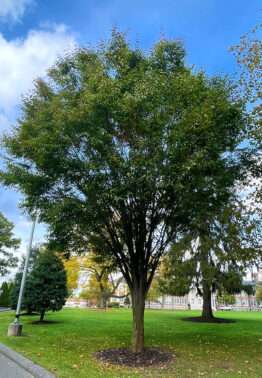Japanese Zelkova
Researched by Sofia DiCastelnuovo
 Species: Zelkova serrata
Species: Zelkova serrata
Common name: Japanese Zelkova
Family: Ulmaceae (Elm Family)
Clade: Angiosperms (flowering seed plants)
Coordinates: 39.70594777, -75.12171992
A tag using this number is placed near the tree.
Zelkova serrata, also known as the Japanese Zelkova tree, was introduced in the U.S. in 1862. The tree thrives in temperate regions and is commonly found along city streets as a shade tree because it tolerates urban conditions well. Native to Eastern Asia and Japan, the species typically has a lifespan of more than 60 years and is part of the Ulmaceae family, commonly known as the elm family. An interesting feature of the Japanese Zelkova is its honeycomb bark, which typically appears gray and brown. The trunk is short, and branches grow upright. Its leaves are simple with serrated edges and grow in an alternate arrangement on the branches. They are narrow, typically one to two inches long, and feel rough on top and smooth underneath.
A deciduous tree, the Japanese Zelkova loses its leaves seasonally, turning from green to yellow-red before dropping for the winter. This tree also produces flowers and fruits, making it an angiosperm. Monoecious, the tree produces male and female flowers, which bloom from April to May. Flowers are pollinated by wind and mature into fruits in summer and fall. The fruit are small green berries that turn brown when ripe and contain seeds. Read More
Campus Species Map
Researcher’s Biography

Sofia DiCastelnuovo
Sofia DiCastelnuovo earned her Bachelor of Science in Biological Sciences in 2023.
Suggested Citation:
DiCastelnuovo, Sofia. (2022, Dec). Japanese Zelkova. Rowan University Arboretum. https://arboretum.rowan.edu/trees/japanese-zelkova/
Questions to Explore
- Why are Japanese Zelkovas highly resistant to Dutch elm disease?
- What happened to the Japanese Zelkova trees affected by stick insects in Japan?
- Why is the Japanese Zelkova tolerant of urban conditions?
References
Culley, T. M., Dreisilker, K., Clair Ryan, M., Schuler, J. A., Cavallin, N., Gettig, R., . . . Shultz, B. (2022). The potential role of public gardens as sentinels of plant invasion. Biodiversity & Conservation, 31(7), 1829-1844. | Link
Yano, K., Ozaki, T., Suzuki, T., Yamazaki, H., Nasuno, M., Degawa, Y., & Tojo, K. (2021). Outbreak of the stick insect, Ramulus mikado (Phasmatodea, Phasmatidae), in the Akashina area of Japan (Azumino City, Nagano Prefecture). Entomological Science, 24(2), 196-200. | Link
Makino, T. (2007). Zelkova Serrata. Plants for a future. | Link
Lahti, H. (2021). Zelkova Serrata. Smithsonian. | Link
Engels, L. (2021). How to Grow Japanese Zelkova Trees. The Spruce. Dotdash Meredith. | Link
Rowan University Resources
You may need to log into the Rowan University Library website.
Dynamics of xylem and phloem sap flow in an outdoor zelkova tree visualized by magnetic resonance imaging | Link
Ecophysiological responses of Japanese forest tree species to ozone, simulated acid rain and soil acidification | Link




















